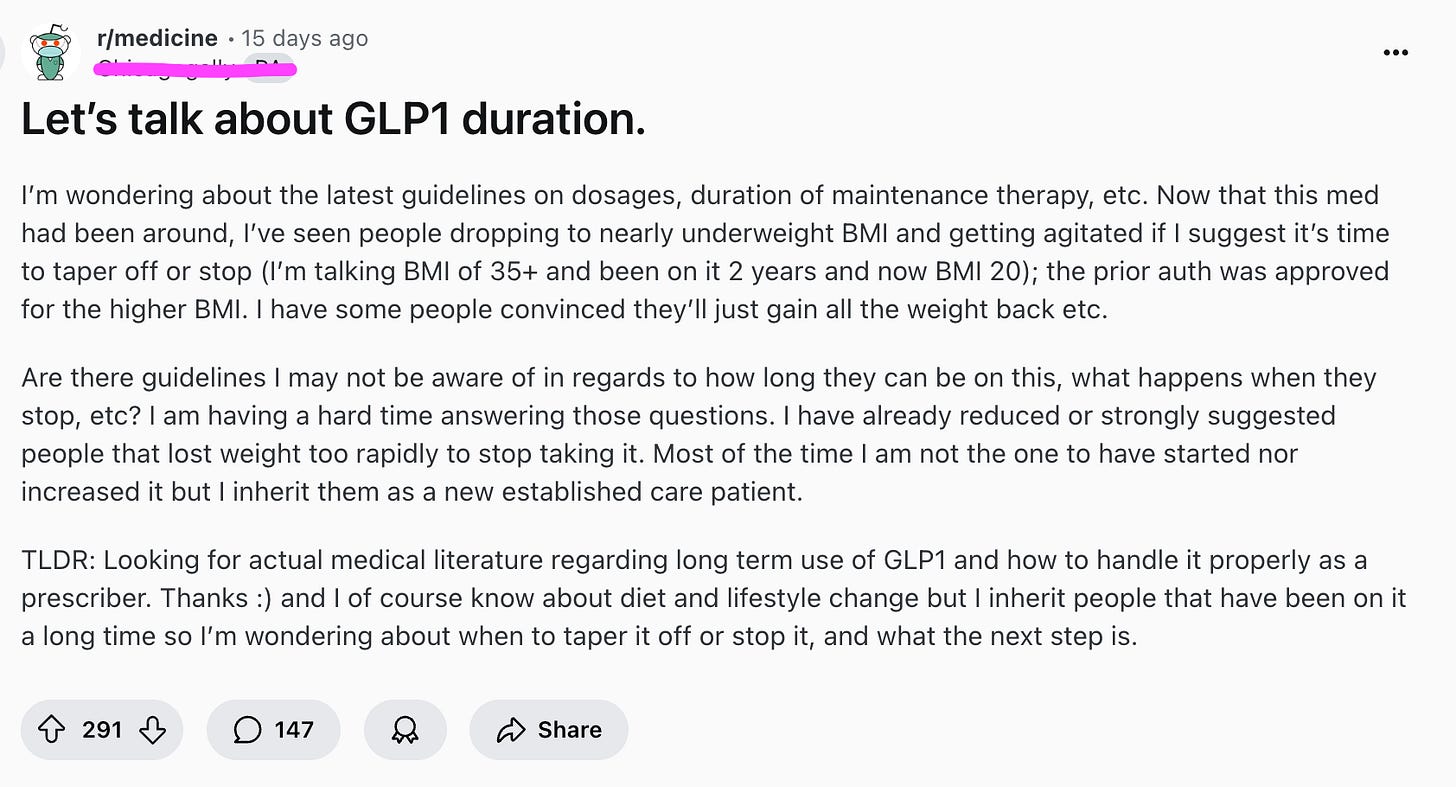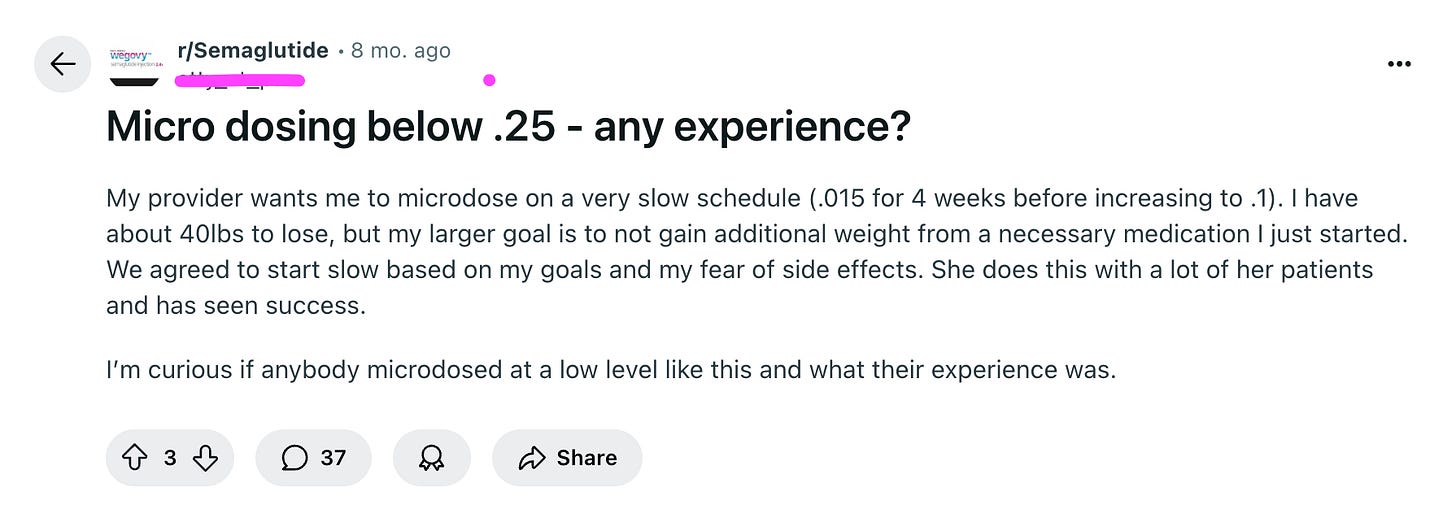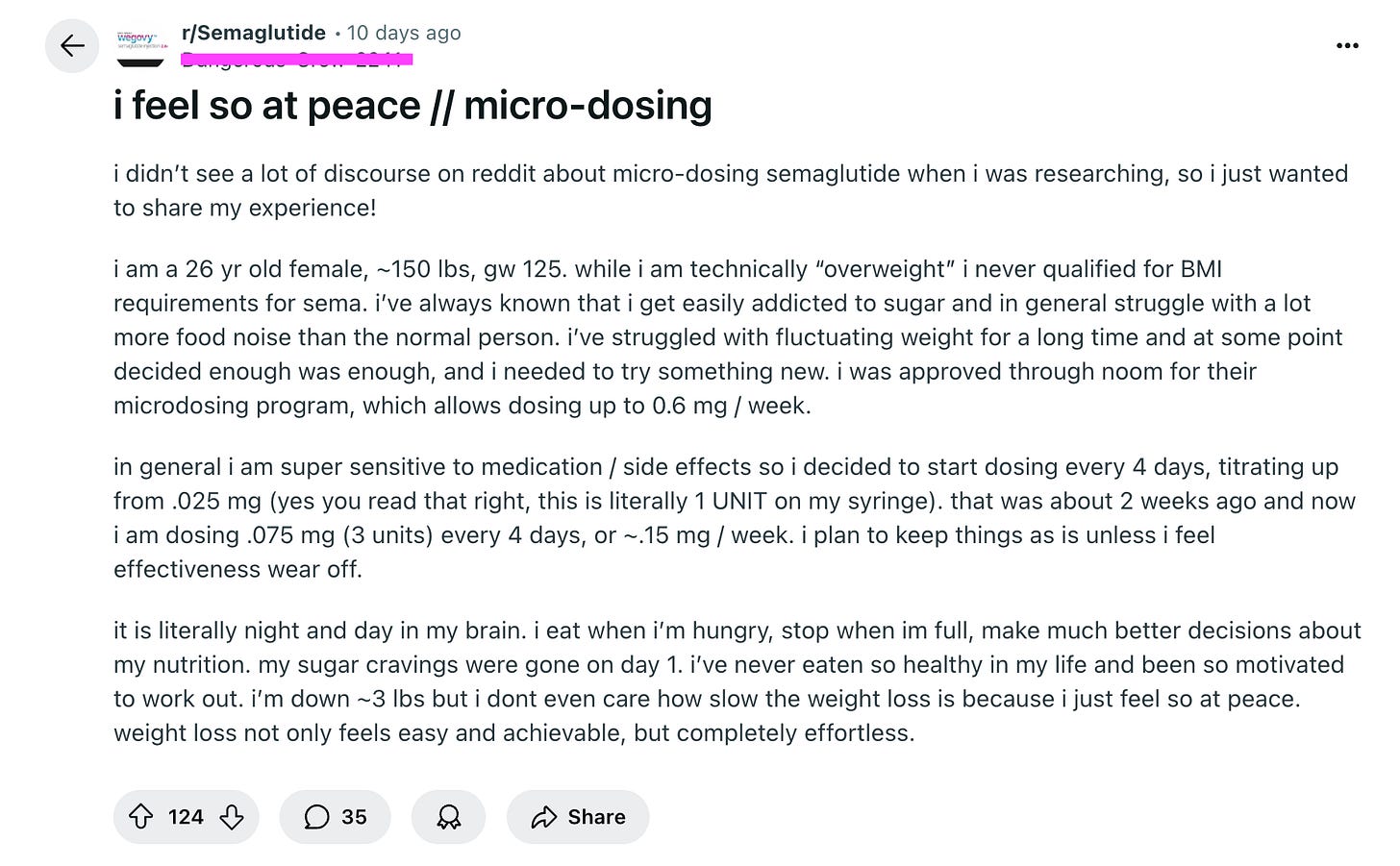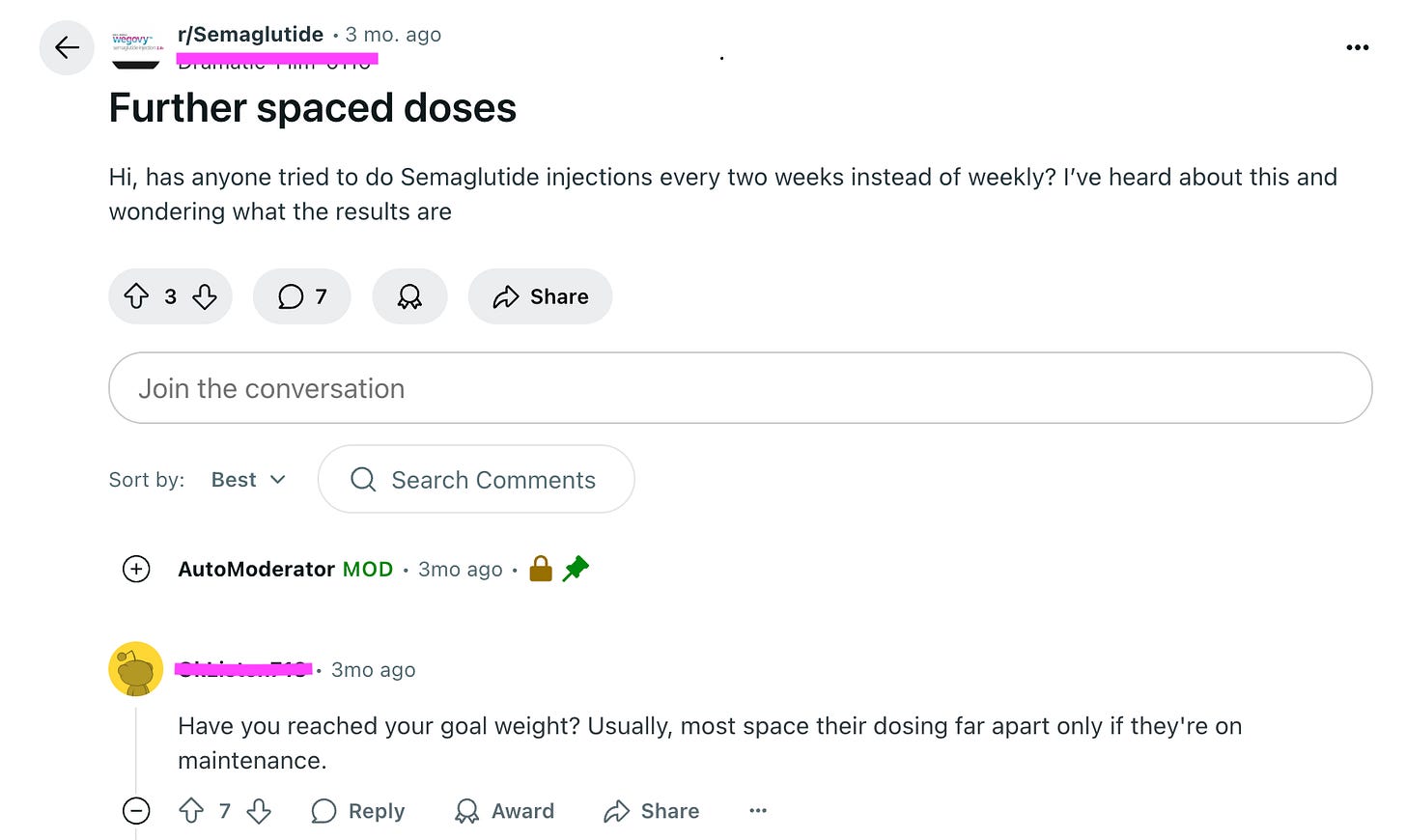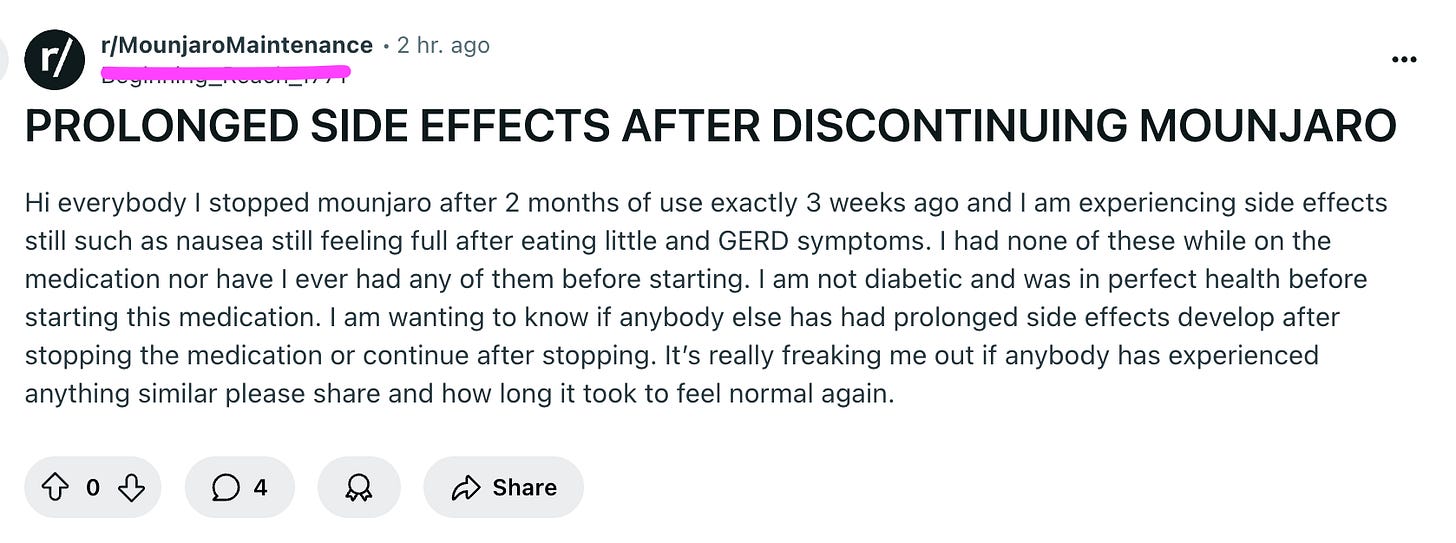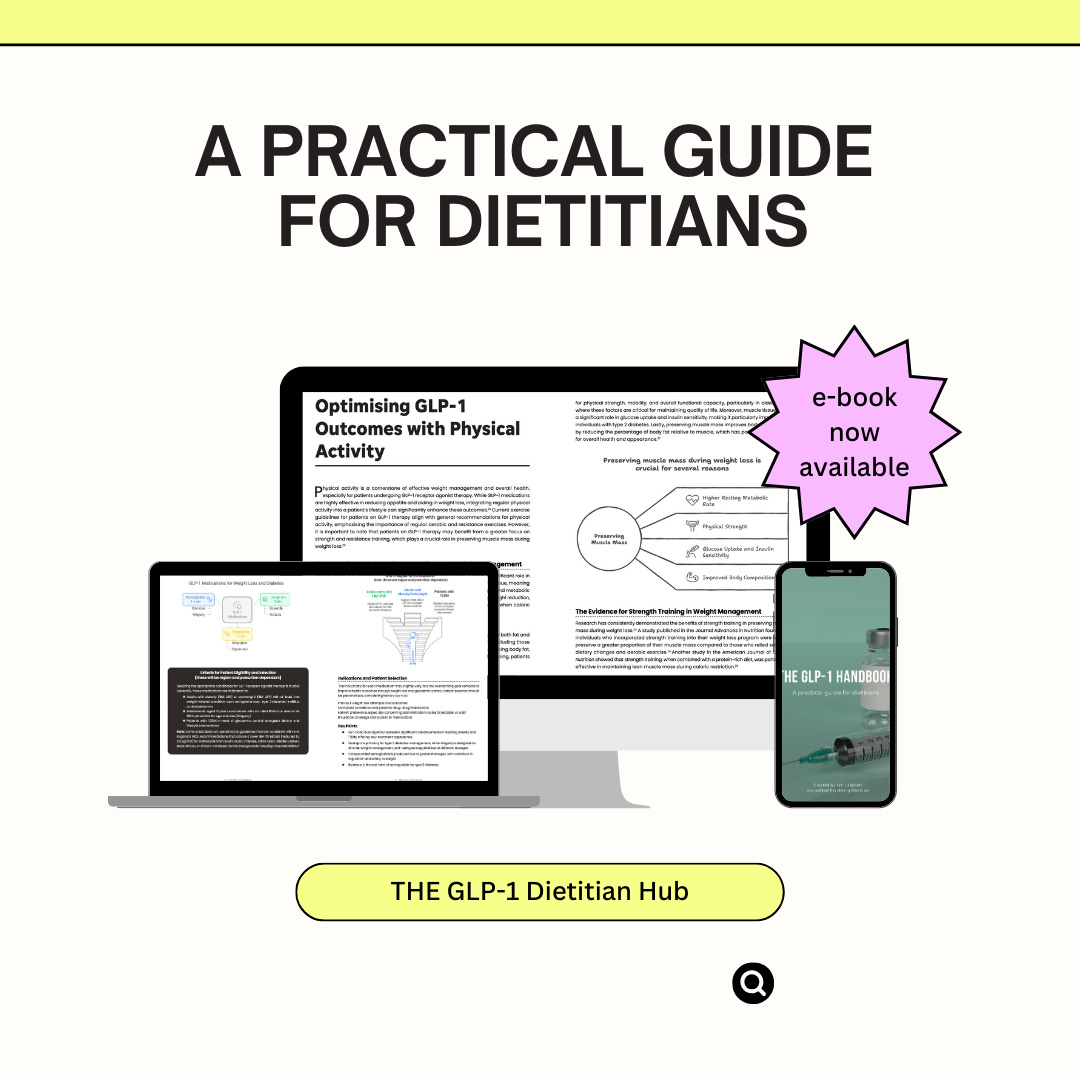Long Term GLP-1 Use: Maintenance and Offboarding
The conversation around GLP-1s is slowly shifting from short term weight loss to long term strategies for maintenance and offboarding. Currently, there is no single, well defined path for long term use. While clinical trial data confirms the effectiveness of ongoing treatment, real world practice highlights a more complex picture - patients and providers are experimenting with medication tapering, spacing, switching, and other adaptations to make therapy more sustainable.
Some of these approaches are supported by emerging evidence, while others remain largely anecdotal. For health professionals, understanding the range of strategies patients are exploring, as well as the evidence (or lack thereof) behind them, is vital to guiding safe and effective care.
The next section explores these approaches in detail.
Current Long Term Options For Patients
Maintaining the current dose
The Approach
Maintaining the current dose means continuing the patient on their established, well tolerated GLP-1 regimen on an ongoing basis to manage obesity and any related chronic conditions. The aim is to preserve achieved weight loss and glycaemic improvements while avoiding unnecessary dose changes. This approach might suit patients with a stable or satisfactory response, good tolerability and no pressing safety, access, or cost concerns.
What Some Of The Evidence Shows So Far
The SURMOUNT 1 study has highlighted the effectiveness of tirzepatide in managing overweight and obesity long term. Participants on the highest dose (15 mg) achieved an average weight reduction of 22.9% over three years, marking one of the longest documented sustained weight loss effects in obesity pharmacotherapy.
Notably, nearly 99% of participants remained free from diabetes at the 176-week mark. Beyond weight loss, tirzepatide also demonstrated significant improvements in fasting insulin, blood pressure, lipid profiles, and overall glycaemic control, reinforcing its potential role in long-term metabolic health management.
Gradual taper of dose
The Approach
For patients who want to find the lowest effective dose or to discontinue completely, a gradual taper means stepping the GLP-1 dose down in small, planned increments (typically using the same titration steps as initiation, but in reverse) to test whether benefit can be maintained with less medication or none at all.
What Some Of The Evidence Shows So Far
Emerging evidence shows that patients who are weaned off GLP1s over several weeks (with progressively lower doses) experience less rebound hunger and can better maintain weight loss. In a real world study, patients who tapered down to zero over 9 weeks (while receiving lifestyle coaching) actually continued to lose a small amount of weight during the taper, and 6 months after stopping, their weight remained essentially stable.
Spacing out dose frequency
The Approach
Spaced out dosing means extending the interval between GLP-1 injections beyond the approved schedule (for example, taking a weekly medicine less often than once a week). Note that this is considered ‘off label’ and risks reduced efficacy, fluctuating appetite control, weight regain, glycaemic deterioration and dosing errors.
What Some Of The Evidence Shows So Far
A 2025 brief case series using modelling examined less frequent dosing of GLP-1s for weight maintenance. Two patients who spaced doses of semaglutide or tirzepatide maintained a large proportion of their prior weight loss, illustrating feasibility in real-world settings. The simulations suggested that moving from weekly to every 14 days preserved about 70% of weight loss seen with weekly dosing, and even monthly dosing maintained roughly half of the effect. The authors noted this is an off-label strategy and called for controlled trials to validate effectiveness and define who might benefit.
Switching to an alternative (non glp-1) anti obesity medication
The Approach
Switching to a non GLP-1 anti obesity medication means replacing the GLP-1 with another approved weight loss medicine to help maintain weight loss. Research in this area remains limited but emerging evidence provides some guidance.
What Some Of The Evidence Shows So Far
A real world study from a US academic weight service followed adults who reached BMI <30 kg/m² after 12 months on GLP-1s within an 18-month “medical weight loss bundle” (12 months of fully covered anti obesity medication therapy plus 6 months of transition care), then transitioned some patients to older, generic anti obesity medicines (metformin, topiramate, bupropion, naltrexone, and phentermine). Among the 40 patients who moved to generics, weight loss achieved on GLP-1 therapy was largely maintained to 18 months and at a later follow-up (593 days) while off GLP-1s.
Microdosing
The Approach
There is no formal definition of what constitutes a “microdose” for GLP-1 medications. In the real world, it generally involves using doses lower than the established therapeutic amount needed to achieve the intended medical benefit. For example, a patient stepping down from 2 mg of semaglutide weekly might see 0.25 mg as a “microdose,” even though it is the standard approved starting dose. In comparison, someone tapering off completely might use even smaller, non standard amounts, such as 0.125 mg weekly, which is not part of approved dosing guidelines and would require manual adjustment.
What Some Of The Evidence Shows So Far
Research on microdosing is limited, with most insights coming from anecdotal accounts rather than controlled clinical trials. Some clinicians report that patients can achieve and maintain weight loss at lower doses but these observations lack formal scientific validation. One notable real world example comes from the digital weight loss clinic Embla, where patients achieved an average 14.8% weight loss at 64 weeks using a maximum mean semaglutide dose of 0.77 mg, about 36% of the standard cumulative dose, while maintaining effectiveness.
From a regulatory standpoint, microdosing is off label and not endorsed by manufacturers or health authorities. Pharmaceutical companies do not provide instructions for altered dosing, regulators have not included it in approved guidelines, and prescribers may assume greater liability if harm occurs.
Common microdosing methods
Some patients adjust doses by counting the audible “clicks” on injection pens such as Ozempic or Wegovy, allowing for smaller dose changes than officially prescribed. For single dose pens like Mounjaro or Zepbound, some will attempt to extract partial doses by breaking open the device, bypassing its built in precision and safety mechanisms. Others using vials, either compounded or branded, may draw up custom doses with a syringe.
Note that each of these methods carries accuracy and safety risks and manufacturers strongly advise against this due to the risk of inaccurate dosing and medication waste.
Cycling on and off GLP-1s (stopping treatment with planned restart)
The Approach
Cycling on and off GLP-1s means taking a planned break from treatment for a defined period, then re-starting on a schedule agreed in advance. This is an off label strategy and differs from spacing doses or tapering because it includes time completely off treatment.
What Some Of The Evidence Shows So Far
To date, there are no randomised or prospective studies testing GLP-1 cycling for weight maintenance or long term management. Published trials evaluate withdrawal or continuation, not planned breaks with re-initiation. Most information comes from patient forums and social media, where reports are mixed: some describe renewed appetite suppression on re-start, while others report weight gain during breaks and significant nausea on resuming previous doses, often requiring a full re-titration.
Completely Stopping GLP-1s
The Approach
Completely stopping means ceasing the medicine with no maintenance dose or planned re-start. It is usually considered for patients who have reached their goals and prefer to trial life off medication, those with ongoing intolerance, new contraindications, pregnancy plans, access or cost barriers, or a change in clinical priorities. In the real world, this is usually done with or without a tapering off plan.
What Some Of The Evidence Shows So Far
Stopping GLP-1 therapy often leads to weight regain. Multiple studies have documented that patients tend to regain a substantial portion of the weight lost once the medication is discontinued. For example, in the STEP 1 trial extension, patients who stopped semaglutide after 68 weeks of treatment regained about two thirds of the weight they had lost within one year of discontinuation. Similarly, the STEP 4 trial found that patients who discontinued semaglutide and switched to a placebo for 48 weeks regained 6.9% of their body weight.
A 2025 systematic review mapped weight change after stopping anti-obesity medicines across 11 RCTs. On average, there was no significant regain at four weeks versus controls, indicating early weight loss was largely maintained at that point. By week 8, regain had begun and was significant (+1.50 kg versus control), rising to +2.50 kg by week 20; thereafter the trajectory plateaued. Regain was observed across subgroups, with significant regain at 12 weeks in trials of GLP-1s. By 52 weeks, despite some regain versus controls, mean weight still remained below baseline.
Keep in mind that individual outcomes after discontinuation will vary. Not everyone regains all the weight immediately. Some real world data shows promise that a few may maintain their full weight loss for at least one year after stopping GLP-1 therapy, especially if they continue with lifestyle improvements.
Additional Factors in Long Term Outcomes
Exercise could play a key role in weight maintenance
A study examining long-term weight loss maintenance after stopping liraglutide therapy found that combining medication with supervised exercise led to significantly better outcomes compared to using GLP-1s alone or a placebo. One year after discontinuation, those who followed a combined exercise and GLP-1 approach regained less weight (7.1 kg) than those who relied solely on GLP-1s (9.6 kg).
Additionally, participants who engaged in both exercise and GLP-1 therapy saw greater improvements in body fat percentage and waist circumference, indicating better long term body composition maintenance.
Discontinuation rates
A retrospective cohort study of over 125,000 U.S. adults found that nearly two thirds of non-diabetic patients (64.8%) discontinued their GLP-1 therapy within one year. Among patients with type 2 diabetes, discontinuation remained high at 46.5% within the first year. Notably, up to 47% of T2D patients and 36% of non-T2D patients restarted their medication within the same timeframe.
Withdrawal effects
When GLP‑1s are stopped, patients may experience a range of physical symptoms. Appetite and food cravings often return within days or weeks. Some individuals describe hypoglycaemia like effects such as weakness, blurred vision or heart palpitations. Gastrointestinal symptoms including nausea, constipation or diarrhoea are also commonly reported.
There can be notable psychological effects too. Many report heightened anxiety, mood fluctuations or a resurgence of persistent thoughts about food. In some cases, users describe experiences of depression or irritability following cessation.
Frameworks To Consider For Long Term Use and Offboarding
Several professional bodies have developed frameworks to guide clinicians in supporting patients who want to consider long term use or discontinuing GLP-1s altogether. The following summary highlights recommendations from the National Institute for Health and Care Excellence (NICE) and a joint advisory from leading U.S. medical societies, offering structured approaches to follow up care, lifestyle planning, and long term weight management.
National Institute for Health and Care Excellence (NICE)
Quality statement on the advice and support people should receive after stopping weight management medicines.
Ensure that people stopping medicines for weight management:
Receive feedback and monitoring at regular intervals for a minimum of 1 year so they can get help if they are not maintaining changes
Have well rehearsed action plans (such as 'if–then' plans) that they can easily put into practice if they are not maintaining changes
Have thought about how they can make changes to their own immediate physical environment to prevent weight regain
Have the social support they need to maintain changes
Are helped to develop routines that support the new behaviour
Are offered a range of options for follow-up sessions after an intervention active phase
Ensure that weight management interventions encourage people to make lifelong behavioural changes and prevent future weight gain, by:
Fostering independence and self-management (including self-monitoring)
Encouraging dietary behaviours that support weight maintenance and can be sustained in the long term
Emphasising the wider benefits of keeping up levels of physical activity over the long term
Discussing strategies to overcome any difficulties in maintaining behavioural changes
Encouraging family-based changes
Discussing sources of ongoing support once the intervention or referral period has ended
Read more here
American College of Lifestyle Medicine, the American Society for Nutrition, the Obesity Medicine Association, and The Obesity Society
While specific nutritional and other behaviours that contribute to weight maintenance after stopping GLP-1 therapy have not been rigorously studied, a joint advisory from several leading American medical societies highlights that other observational data can show general predictors for successful long term weight reduction.
Recommendations include:
Lay the groundwork early. Establish nutrition and lifestyle habits during GLP-1 use so they are easier to sustain if treatment stops.
Make maintenance a primary goal. Aim to preserve health gains for as long as possible.
Predictors of success to reinforce:
Eat at consistent times, including a regular breakfast.
Choose mostly minimally processed foods that are rich in protein and fibre.
Limit sugary drinks, highly processed foods and habitual snacking.
Allow flexibility with portion controlled treats to avoid rigid restriction.
Supportive behaviours to encourage:
Target about 60 minutes of physical activity per day, accumulated across the week.
Monitor weight, food intake and activity consistently.
Keep discretionary screen time under 10 hours per week.
Use social support, advance planning and problem-solving to stay on track.
Read more here
Real World Perspectives on Long Term Use
Discussions about GLP-1s in online communities and patient groups reveal a growing acceptance of these medications as ongoing treatment rather than short term interventions. Many clinicians frame obesity as a chronic condition, and this view has filtered into patient conversations, with some describing GLP-1s as part of a permanent lifestyle plan. References to evidence of weight regain after stopping treatment often reinforce this perspective, although sentiment varies widely based on personal experience, cost, and access.
Patient forums such as Reddit and Facebook provide a window into real world management strategies and underline that there is no single agreed upon maintenance pathway. Users often share practical approaches, experimenting with dosing schedules to balance appetite control, side effects, and affordability. Some report success maintaining weight through lifestyle changes alone, but most highlight a rapid return of hunger and weight regain if medication is stopped abruptly, underscoring the need for structured support when adjusting or discontinuing treatment.
Below is a tiny sample of Reddit and Facebook threads that capture common themes from patients and clinicians navigating long term GLP-1 use:
Closing Thoughts
Long term use and discontinuing GLP-1s is unlikely to follow a single, uniform pathway. Patient experiences show that cost, tolerability, lifestyle, and personal goals all influence whether they continue, taper, cycle, or stop altogether. While the evidence base for some of these approaches is developing, clinicians play an incredibly important role by providing structured monitoring, reinforcing sustainable lifestyle practices, and tailoring support to individual needs. Future research will be critical in shaping how health professionals support patients to make confident, informed choices about their long term options.
Ready to Go Beyond the Basics?
The GLP-1 Handbook is your go to reference, filled with clear guidance and patient ready resources designed for immediate application in your consults.
Navigating Weight Loss Medications: A Short Course for Dietitians
Want to build a deeper, strategic understanding? This structured course offers theory and real world learning to solidify your expertise and help you navigate GLP-1s with confidence.
References
Jastreboff, A.M., Aronne, L.J., Ahmad, N.N., Wharton, S., Connery, L., Alves, B., Kiyosue, A., Zhang, S., Liu, B., Bunck, M.C. and Stefanski, A., 2022. 'Tirzepatide Once Weekly for the Treatment of Obesity'. New England Journal of Medicine, 387(3), pp. 205–216. DOI: 10.1056/NEJMoa2206038.
Gudbergsen H, et al. Embla Clinic study (ECO 2024) – EASO Conference Abstract – Personalized dosing and tapering of semaglutide for weight maintenance (Is coming off semaglutide slowly the key to preventing weight regain? - EASO).
Wu CC, Cengiz A, Lawley SD. Less frequent dosing of GLP-1 receptor agonists as a viable weight maintenance strategy. Obesity (Silver Spring). 2025 Jul;33(7):1232-1236. doi: 10.1002/oby.24302. Epub 2025 May 25. PMID: 40415172; PMCID: PMC12210098.
Paddu NU, Lawrence B, Wong S, Poon SJ, Srivastava G. Weight maintenance on cost-effective antiobesity medications after 1 year of GLP-1 receptor agonist therapy: a real-world study. Obesity (Silver Spring). 2024 Dec;32(12):2255-2263. doi: 10.1002/oby.24177. Epub 2024 Nov 18. PMID: 39558626; PMCID: PMC11589535.
Wilding JPH, Batterham RL, Davies M, Van Gaal LF, Kandler K, Konakli K, Lingvay I, McGowan BM, Oral TK, Rosenstock J, Wadden TA, Wharton S, Yokote K, Kushner RF; STEP 1 Study Group. Weight regain and cardiometabolic effects after withdrawal of semaglutide: The STEP 1 trial extension. Diabetes Obes Metab. 2022 Aug;24(8):1553-1564. doi: 10.1111/dom.14725. Epub 2022 May 19. PMID: 35441470; PMCID: PMC9542252.
Wu, H., Yang, W., Guo, T. et al. Trajectory of the body weight after drug discontinuation in the treatment of anti-obesity medications. BMC Med 23, 398 (2025). https://doi.org/10.1186/s12916-025-04200-0
The Lancet. (2025) 'Healthy weight loss maintenance with exercise, GLP-1 receptor agonist, or both combined followed by one year without treatment: a post-treatment analysis of a randomised placebo-controlled trial' [Accessed 19 Jan. 2025].
Rubino D, Abrahamsson N, Davies M, et al. Effect of Continued Weekly Subcutaneous Semaglutide vs Placebo on Weight Loss Maintenance in Adults With Overweight or Obesity: The STEP 4 Randomized Clinical Trial. JAMA. 2021;325(14):1414–1425. doi:10.1001/jama.2021.3224
Rodriguez PJ, Zhang V, Gratzl S, et al. Discontinuation and Reinitiation of Dual-Labeled GLP-1 Receptor Agonists Among US Adults With Overweight or Obesity. JAMA Netw Open. 2025;8(1):e2457349. doi:10.1001/jamanetworkopen.2024.57349
NICE (2025) Quality statement 7: Advice and support after stopping medicines for weight management or completing behavioural interventions (Accessed: 10 August 2025).
Mozaffarian D, Agarwal M, Aggarwal M, Alexander L, Apovian CM, Bindlish S, Bonnet J, Butsch WS, Christensen S, Gianos E, Gulati M, Gupta A, Horn D, Kane RM, Saluja J, Sannidhi D, Stanford FC, Callahan EA. Nutritional priorities to support GLP-1 therapy for obesity: A joint Advisory from the American College of Lifestyle Medicine, the American Society for Nutrition, the Obesity Medicine Association, and The Obesity Society. Obesity (Silver Spring). 2025 May 30. doi: 10.1002/oby.24336. Epub ahead of print. PMID: 40445127.


